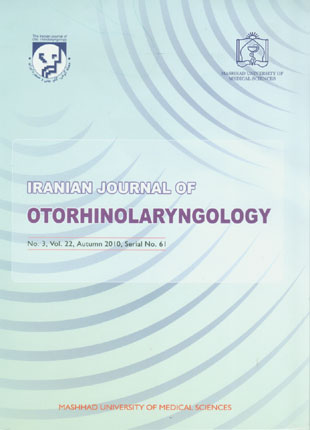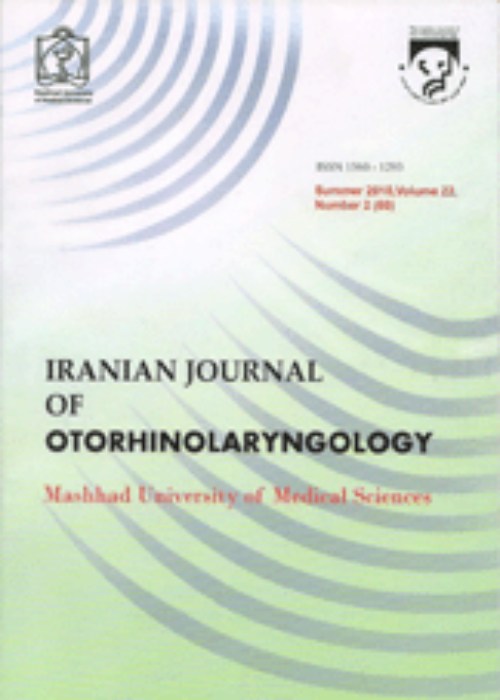فهرست مطالب

Iranian Journal of Otorhinolaryngology
Volume:22 Issue: 4, Sep-Oct 2010
- تاریخ انتشار: 1389/10/11
- تعداد عناوین: 8
-
-
Page 111Recent developments in medicine have given us a better insight into a group of disorders known as autoimmune diseases. In particular, advances have occurred in our understanding of the Autoimmune Inner Ear Disease (AIED). In this article, the authors review the different postulated theories in the pathogenesis of this disease. The clinical presentation, the available para-clinical diagnostic tools, and the important differential diagnoses will be summarized. The management methods, including steroid therapy, immunosuppressive medications, other biological agents and intra-tympanic injections, will be addressed. Cochlear implantation as a final solution to the advanced stages of the disease, causing total deafness, will also be discussed.
-
Page 117IntroductionBlunt neck and laryngeal trauma is rare. Since such injuries can be life threatening, their early management remarkably affects the immediate probability of patients’ survival and their long-term quality of life.Materials And MethodsIn this retrospective and descriptive study, medical records of 54 patients with blunt neck and laryngeal trauma, who were referred to Imam Khomeini Hospital in Ahwaz over an 11-year period, were evaluated. The collected data were then analyzed by descriptive statistical tests.ResultsMean age of the patients was 26 years and injuries were mostly seen in males. The most common etiological factors of blunt neck and laryngeal trauma included violent behavior and vehicle accidents. Neck pain, tenderness, odynophasia and neck edema were observed as the main clinical manifestations in patients. The main injured organs consisted of the neck, larynx and FVC (False vocal cord). Neck CT Scan was applied as the most common diagnostic method and conservative therapy as the most common therapeutic modality. It was reported that most patients suffered from minor injuries.ConclusionSince any delay in early diagnosis and treatment of the patients is life threatening, accurate and immediate diagnostic and therapeutic procedures should be followed by skillful airway management and frequent evaluation of any changes.
-
Page 123IntroductionLaryngectomy in patients with laryngeal cancer can lead to the reduction of nutritional parameters. Supportive treatments and supplementary nutritional supports are recommended in all patients undergoing laryngectomy, even with acceptable preoperative nutritional indices.The aim of this study was to evaluate postoperative changes in nutritional parameters in patients with laryngeal cancer undergoing laryngectomy.Materials And MethodsIn a prospective study from 2005 to 2007, 30 candidate patients for total laryngectomy in Amir Alam Hospital in Tehran were included for final diagnosis of squamous cell carcinoma (stage T4). Nutritional parameters including body mass index (BMI), serum levels of albumin, hemoglobin, total protein concentration, total lymphocyte number and percentage were assessed one week before and one month after laryngectomy. All patients used their routine dietary regimens and those who received nutritional supplementation after surgery were excluded from the study.ResultsExcept for white blood cell count, a significant reduction was found in BMI, lymphocyte count, serum hemoglobin, total protein and albumin levels after surgery (P<0.001). There were no significant differences between the change in nutritional parameters after laryngectomy and the increase in age; BMI (P=0.054), hemoglobin (P=0.406), total protein (P=0.103), and albumin (P=0.132), postoperative length of hospital stay and concomitant neck dissection.ConclusionLaryngectomy in patients with laryngeal cancer leads to the reduction of nutritional parameters but these changes do not depend on the patient's age, concurrent neck dissection and length of hospital stay; however, the supportive approaches can also be recommended in patients leaving hospital without any serious complications.
-
Page 131IntroductionMyofascial Pain Dysfunction Syndrome (MPDS) is one of the most important causes of the orofacial pain. The main purpose of this study was to evaluate 40 related variables in this regard.Materials And MethodsThirty nine patients with MPDS were evaluated in this study. Different factors including age, gender, occupation, marital status, sensitivity of masticatory muscles, maximum opening of the mouth, deviation, deflection, involvement of temporomandibular joint, habit, parafunction, malocclusion, neck pain, headache, earache and history of jaw involvement, etc were analyzed in this evaluation.ResultsIn our study, 39 patients (32 females and 7 males), 20-40 years old, with the average age of 35 ± 13.32 years were studied. 51% were housewives and 74.4% were married. The most common involvements were Clicking (74.4%), pain in temporomandibular joint (54%), headache (46.2%), earache (41%), neck-pain (35.9%), trouble in the mouth opening (71.8%), malocclusion Class I (74.4%), cross bite and deep bite (25%), clenching (64.1%) and involvement of masseter and lateral pterygoid muscle (84%).ConclusionSince MPDS consists of variable symptoms, it might be very difficult to provide any definite diagnosis and treatment. Therefore the more the specialists extend their knowledge and information about this disorder, the more they will make the best decision in this regard.
-
Page 137IntroductionTonsillectomy with or without adenoidectomy is one of the most frequent surgical procedures especially in children. Several indications and contraindications have been suggested for this procedure. The benefits and the negative results of this operation have been studied by different researchers; nevertheless, to date, it is still a common procedure.The main purpose of this study is to obtain extensive information on the outcomes of adenotonsillectomy, according to the patient's physical, emotional and behavioral changes and also on the overall changes in his/her quality of life (QOL).Materials And MethodsAll the children, aged 1-14, referred to the Besat Hospital clinics (Hamadan, Iran) between March 2008 and March 2009 were included in this study. Overall, 86 children with documented indications underwent adenotonsillectomy, and were followed up for one year. Two modified standard questionnaires for QOL were completed before and one year after the tonsillectomy. Upon the completion of this two-year study, statistical analyses were performed, and the demographic data of the study groups were compared with those of a same-age group.ResultsChanges were observed in five main complaints as follow: Acute Recurrent tonsillitis was present in 86 patients preoperatively, but in only three cases postoperatively (pharyngitis). Confirmed chronic sinusitis was present in 24 patients preoperatively, but only in three cases during the year after the surgery. Oral breathing was seen in 82 patients preoperatively, but only in one patient during the year after the surgery. Nocturnal snoring was seen in 83 children preoperatively, but in 25 cases during the year after the surgery. Halitosis was present in 71 patients, while and halitosis was seen in 27 during the year after the surgery.ConclusionOverall, the majority of the parameters studied showed significant differences after surgery.
-
Page 145IntroductionThe preoperative diagnostic evaluation of the parotid lesion is a valuable aid in planning the operation and the approach to intervention. Among different diagnostic tools, Fine Needle Aspiration has a key role. However, the exact efficacy of this technique in our center had not been thoroughly investigated.Materials And MethodsBetween January 2000 and June 2007 a subset of 64 patients who had agreed to undergo preoperative FNAB was selected. The FNAB diagnoses were compared with those of the surgical specimens as the gold standard. Then, sensitivity, specificity, predictive value, and pertinent characteristics of the patients were evaluated. Finally, the results were analyzed with SPSS version14.ResultsDuring the study period, 81 patients underwent parotidectomy, only 64 of whom had the FNA before surgery, so only the data collected from 64 patients were evaluated. The most common clinical presentation 75% (48 patients) was a parotid mass. The second common presentation was facial paralysis at 17.2% (11 patients), followed by pain at 7.8%. The result of FNA sensitivity was 82.5% and specificity was 93.3%. The accuracy of the test was 87.5%. Positive predictive value was 93.3% and negative predictive value was 82.35%.ConclusionFine-needle aspiration cytology is a reliable method in the evaluation of parotid tumors with a fairly high specificity and sensitivity rate.
-
Page 151IntroductionHeterotopic gastrointestinal cyst of the oral cavity is an extremely rare lesion with fewer than 40 cases reported in the English literature. It usually involves the soft tissue covering the floor of the mouth and the tongue. Lining of this lesion resembles gastric or intestinal mucosa. Case Report:In this report we describe the lesion in two boys and discuss their pathogenesis.
-
Page 155IntroductionChronic sclerosing sialadenitis is a relatively uncommon disorder of the salivary gland. Because of its clinical similarity to a salivary gland neoplasm, this condition has been known as Kuttner tumor and is classified as a tumorlike lesion. Case Report:This is the first reported case of bilateral Kuttner tumor of the submandibular glands in Iran. It was initially diagnosed as a primary submandibular gland neoplasm whereas histological findings showed chronic sialadenitis. Excision of such masses is the treatment of choice.


